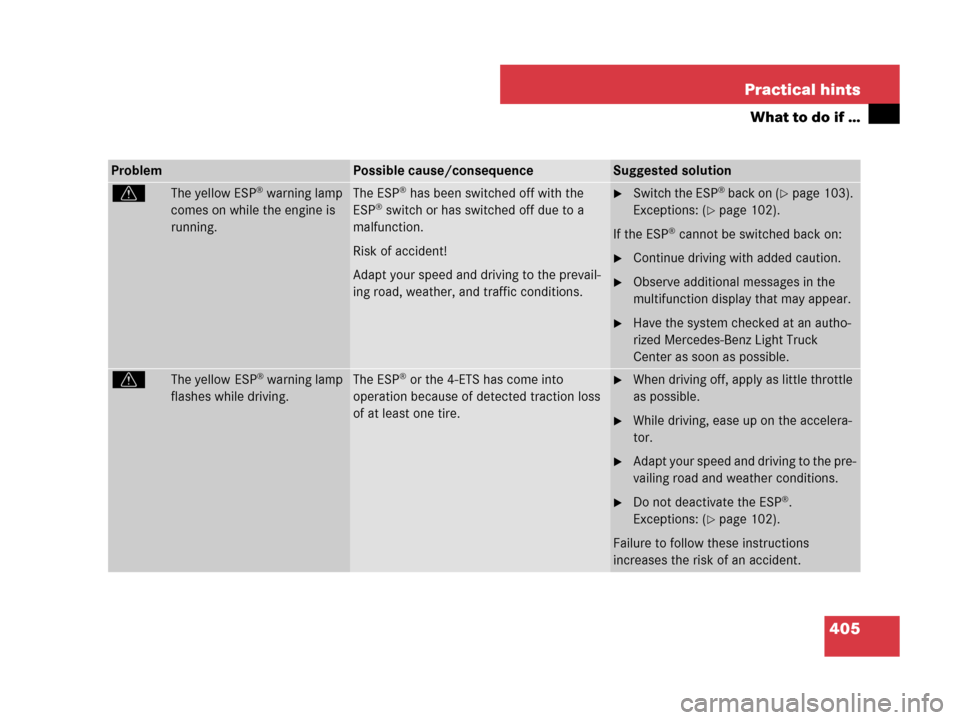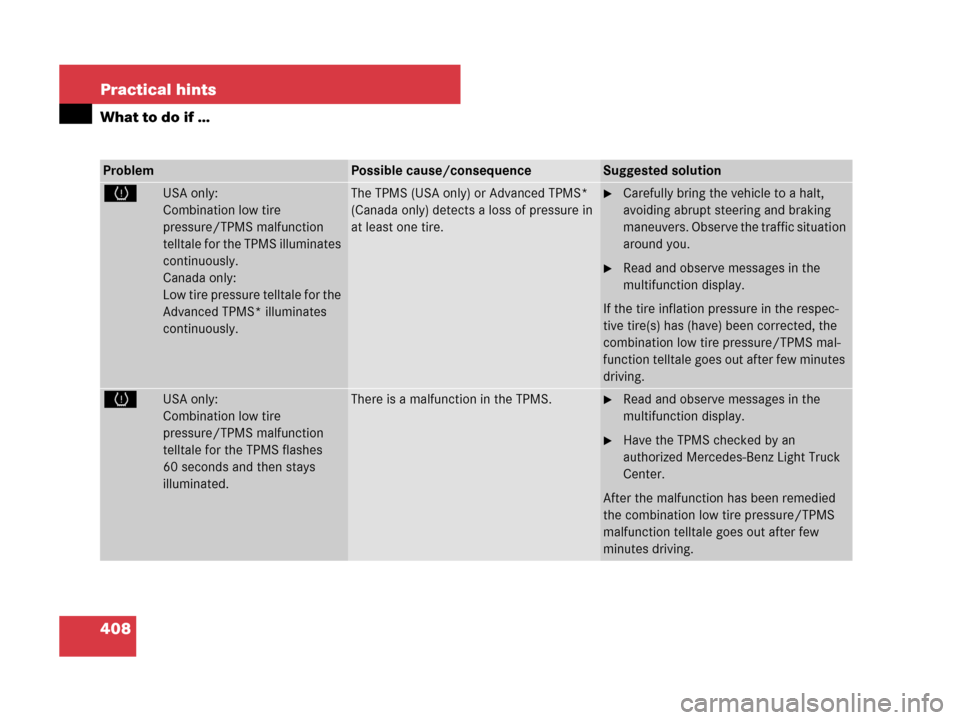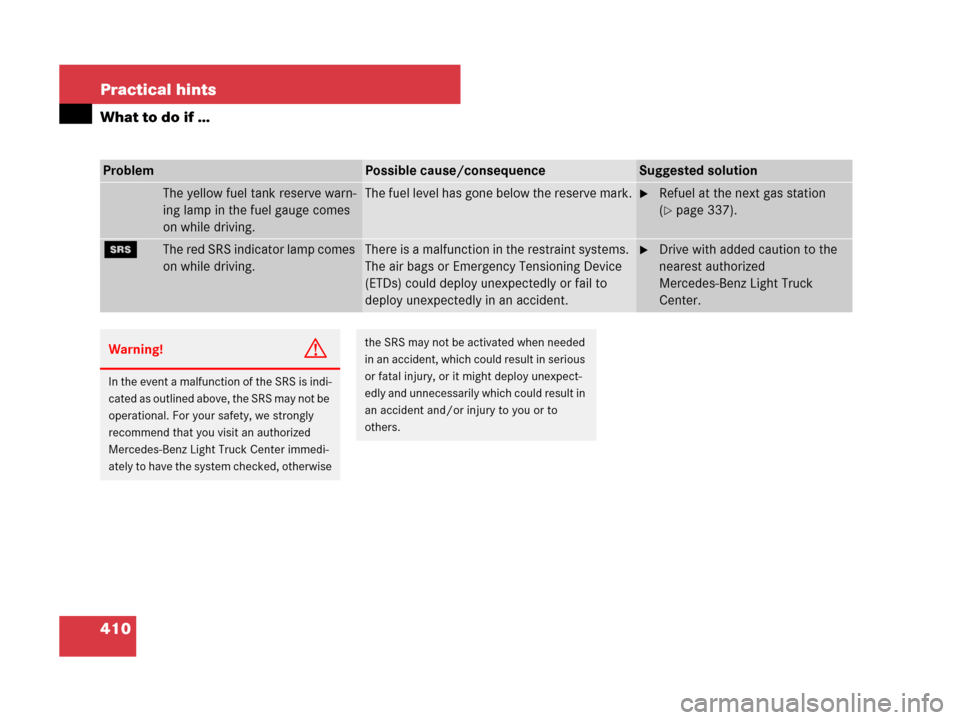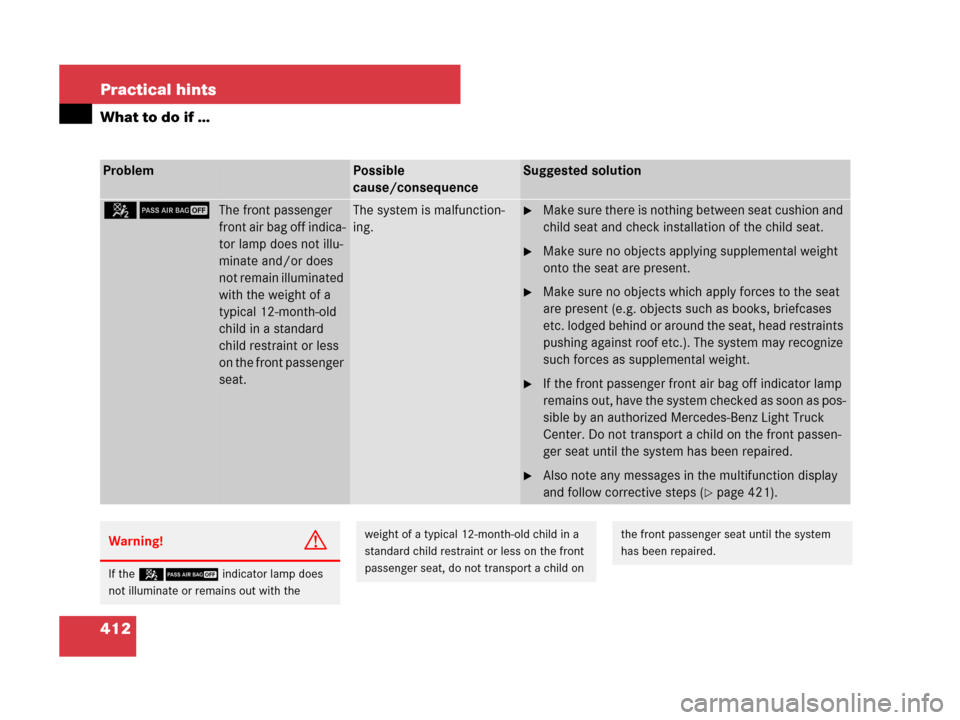Page 404 of 561

403 Practical hints
What to do if …
ProblemPossible cause/consequenceSuggested solution
?(USA only)
±(Canada only)
The yellow engine malfunc-
tion indicator lamp comes on
while driving.There is a malfunction in:
�The fuel management system
�The ignition system
�The emission control system
�Systems which affect
emissions
Such malfunctions may result in
excessive emissions values and
may switch the engine to its
limp-home (emergency opera-
tion) mode.
�Have the vehicle checked as soon as
possible by an authorized
Mercedes-Benz Light Truck Center.
An on-board diagnostic connector is
used by the service station to link the
vehicle to the shop diagnostics
system. It allows the accurate identi-
fication of system malfunctions
through the readout of diagnostic
trouble codes. It is located in the
front left area of the footwell next to
the parking brake pedal.
iSome states may by law require you to visit
a workshop as soon as the engine malfunction
indicator lamp comes on. Check local require-
ments.
Page 405 of 561
404 Practical hints
What to do if …
ProblemPossible cause/conse-
quenceSuggested solution
?(USA only)
±(Canada only)
The yellow engine malfunction
indicator lamp comes on while
driving.A loss of pressure has been
detected in the fuel system.
The fuel cap may not be closed
properly or the fuel system
may be leaky.�Check the fuel cap (�page 337).
If it is not closed properly:
�Close the fuel cap.
If it is closed properly:
�Have the fuel system checked by an
authorized Mercedes-Benz Light Truck
Center.
Vehicles with diesel engine:
Your fuel tank is empty.�After refueling start, turn off and
restart the engine three or four times in
succession.
The limp-home mode is canceled. You do
not need to have your vehicle checked.
Page 406 of 561

405 Practical hints
What to do if …
ProblemPossible cause/consequenceSuggested solution
vThe yellow ESP® warning lamp
comes on while the engine is
running.The ESP® has been switched off with the
ESP® switch or has switched off due to a
malfunction.
Risk of accident!
Adapt your speed and driving to the prevail-
ing road, weather, and traffic conditions.
�Switch the ESP® back on (�page 103).
Exceptions: (
�page 102).
If the ESP
® cannot be switched back on:
�Continue driving with added caution.
�Observe additional messages in the
multifunction display that may appear.
�Have the system checked at an autho-
rized Mercedes-Benz Light Truck
Center as soon as possible.
vThe yellow ESP® warning lamp
flashes while driving.The ESP® or the 4-ETS has come into
operation because of detected traction loss
of at least one tire.�When driving off, apply as little throttle
as possible.
�While driving, ease up on the accelera-
tor.
�Adapt your speed and driving to the pre-
vailing road and weather conditions.
�Do not deactivate the ESP®.
Exceptions: (
�page 102).
Failure to follow these instructions
increases the risk of an accident.
Page 409 of 561

408 Practical hints
What to do if …
ProblemPossible cause/consequenceSuggested solution
HUSA only:
Combination low tire
pressure/TPMS malfunction
telltale for the TPMS illuminates
continuously.
Canada only:
Low tire pressure telltale for the
Advanced TPMS* illuminates
continuously.The TPMS (USA only) or Advanced TPMS*
(Canada only) detects a loss of pressure in
at least one tire.�Carefully bring the vehicle to a halt,
avoiding abrupt steering and braking
maneuvers. Observe the traffic situation
around you.
�Read and observe messages in the
multifunction display.
If the tire inflation pressure in the respec-
tive tire(s) has (have) been corrected, the
combination low tire pressure/TPMS mal-
function telltale goes out after few minutes
driving.
HUSA only:
Combination low tire
pressure/TPMS malfunction
telltale for the TPMS flashes
60 seconds and then stays
illuminated.There is a malfunction in the TPMS.�Read and observe messages in the
multifunction display.
�Have the TPMS checked by an
authorized Mercedes-Benz Light Truck
Center.
After the malfunction has been remedied
the combination low tire pressure/TPMS
malfunction telltale goes out after few
minutes driving.
Page 410 of 561

409 Practical hints
What to do if …
Warning!G
Each tire, including the spare (if provided),
should be checked monthly when cold and
inflated to the inflation pressure recom-
mended by the vehicle manufacturer on the
Tire and Loading Information placard on the
driver’s door B-Pillar or, if available, the tire
inflation pressure label on the fuel filler flap.
If your vehicle has tires of a different size
than the size indicated on the Tire and
Loading Information placard or, if available,
the tire inflation pressure label, you should
determine the proper tire inflation pressure
for those tires.
As an added safety feature, your vehicle has
been equipped with a tire pressure monitor-
ing system (TPMS) that illuminates a low tire
pressure telltale when one or more of your
tires is significantly underinflated. Accord-
ingly, when the low tire pressure telltale illu-
minates, you should stop and check your
tires as soon as possible, and inflate them to
the proper pressure. Driving on a significant-
ly underinflated tire causes the tire too over-
heat and can lead to tire failure.
Underinflation also reduces fuel efficiency
and tire tread life, and may affect the vehi-
cle’s handling and stopping ability. Please
note that the TPMS is not a substitute for
proper tire maintenance, and it is the driv-
er’s responsibility to maintain correct tire
pressure, even if underinflation has not
reached the level to trigger illumination of
the TPMS low tire pressure telltale.USA only:
Your vehicle has also been equipped with a
TPMS malfunction indicator to indicate
when the system is not operating properly.
The TPMS malfunction indicator is com-
bined with the low tire pressure telltale.
When the system detects a malfunction, the
telltale will flash for approximately 1 minute
and then remain continuously illuminated.
This sequence will continue upon subse-
quent vehicle start-ups as long as the
malfunction exists. When the malfunction
indicator is illuminated, the system may not
be able to detect or signal low tire pressure
as intended.
TPMS malfunctions may occur for a variety
of reasons, including the installation of in-
compatible replacement or alternate tires or
wheels on the vehicle that prevent the TPMS
from functioning properly. Always check the
TPMS malfunction telltale after replacing
one or more tires or wheels on your vehicle
to ensure that the replacement or alternate
tires and wheels allow the TPMS to continue
to function properly.
Page 411 of 561

410 Practical hints
What to do if …
ProblemPossible cause/consequenceSuggested solution
The yellow fuel tank reserve warn-
ing lamp in the fuel gauge comes
on while driving.The fuel level has gone below the reserve mark.�Refuel at the next gas station
(
�page 337).
1The red SRS indicator lamp comes
on while driving.There is a malfunction in the restraint systems.
The air bags or Emergency Tensioning Device
(ETDs) could deploy unexpectedly or fail to
deploy unexpectedly in an accident.�Drive with added caution to the
nearest authorized
Mercedes-Benz Light Truck
Center.
Warning!G
In the event a malfunction of the SRS is indi-
cated as outlined above, the SRS may not be
operational. For your safety, we strongly
recommend that you visit an authorized
Mercedes-Benz Light Truck Center immedi-
ately to have the system checked, otherwise
the SRS may not be activated when needed
in an accident, which could result in serious
or fatal injury, or it might deploy unexpect-
edly and unnecessarily which could result in
an accident and/or injury to you or to
others.
Page 412 of 561
411 Practical hints
What to do if …
Lamp in center console
ProblemPossible cause/consequenceSuggested solution
59The front passenger
front air bag off indica-
tor lamp illuminates
and remains illuminat-
ed with the weight of a
typical adult or some-
one larger than a small
individual on the front
passenger seat.The system is malfunctioning.�Have the system checked as soon as
possible by an authorized
Mercedes-Benz Light Truck Center.
�Also read and observe any messages
in the multifunction display and follow
corrective steps (
�page 421).
Warning!G
If the59indicator lamp
illuminates and remains illuminated with the
weight of a typical adult or someone larger
than a small individual on the front passen-
ger seat, do not have any passenger use the
front passenger seat until the system has
been repaired.
Page 413 of 561

412 Practical hints
What to do if …
ProblemPossible
cause/consequenceSuggested solution
59The front passenger
front air bag off indica-
tor lamp does not illu-
minate and/or does
not remain illuminated
with the weight of a
typical 12-month-old
child in a standard
child restraint or less
on the front passenger
seat.The system is malfunction-
ing.�Make sure there is nothing between seat cushion and
child seat and check installation of the child seat.
�Make sure no objects applying supplemental weight
onto the seat are present.
�Make sure no objects which apply forces to the seat
are present (e.g. objects such as books, briefcases
etc. lodged behind or around the seat, head restraints
pushing against roof etc.). The system may recognize
such forces as supplemental weight.
�If the front passenger front air bag off indicator lamp
remains out, have the system checked as soon as pos-
sible by an authorized Mercedes-Benz Light Truck
Center. Do not transport a child on the front passen-
ger seat until the system has been repaired.
�Also note any messages in the multifunction display
and follow corrective steps (
�page 421).
Warning!G
If the59indicator lamp does
not illuminate or remains out with the
weight of a typical 12-month-old child in a
standard child restraint or less on the front
passenger seat, do not transport a child onthe front passenger seat until the system
has been repaired.